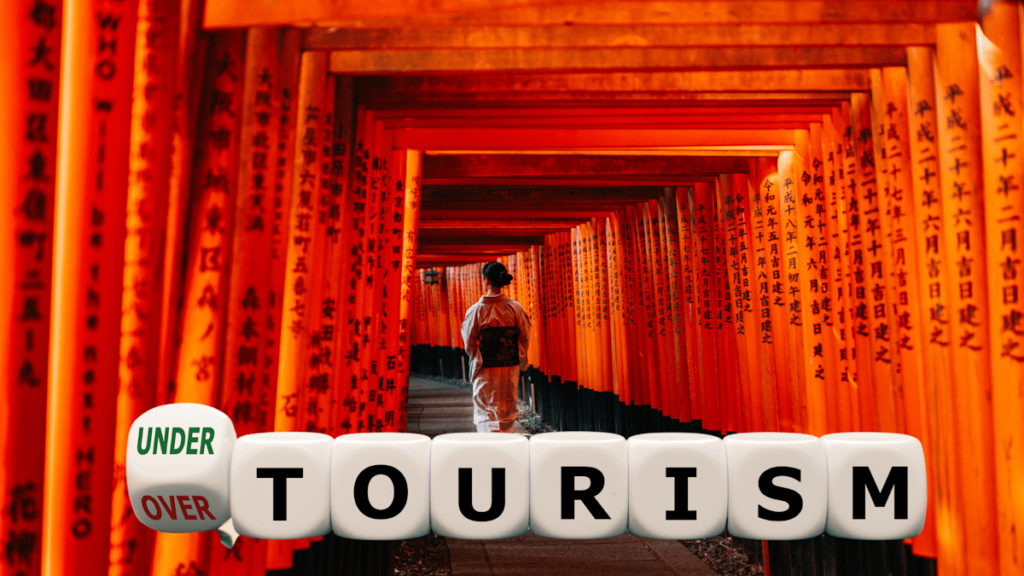[ad_1]
As tourism to Japan ramps back up, many businesses are smiling. But residents in traditional and trending tourist hotspots are fuming. They say that “overtourism” is pushing them off of public transit and making daily life difficult. Here’s how Japan’s national and local governments are responding – and what you can do to help.
From no tourists to “no more tourists”

Overtourism isn’t a new concern in Japan. We wrote back in 2019 about how some stores were refusing to serve non-Japanese (or, at their more charitable, non-Japanese speakers) because of a lack of foreign language-capable staff. The government had also instituted a 1000 yen (appr. $7) “sayonara tax” on airfare tickets to help improve tourist experiences.
Of course, this was all before an international health crisis in 2019 derailed travel everywhere. The pandemic upended, not only inbound tourism, but domestic tourism as well.
Japan’s travel industry is still recovering from this shock. The good news is, it’s recovering briskly. The last we wrote about this issue, inbound tourism (tourism from other countries) was up to about 63% of its pre-pandemic level. It’s now up to about 70%.
Tourism from China lags due to the ongoing tensions between the two countries; it’s only about 64% of pre-pandemic levels. But visitors from certain countries, such as the United States, are already exceeding their 2019 totals.
Domestic tourism is also booming again. According to Japan’s Yomiuri Shimbun, hotel bookings by Japanese residents are up compared to last year.
This is all good for businesses that depend on tourism. It is, however, taxing on one specific kind of business: Japan’s tourism industry. The industry remains short-staffed relative to 2019. That’s meant that certain kinds of tourism – such as outbound tourism by Japanese residents – have been slow to rebound.
Advertisements
Another group feeling the pinch from people flooding into hot tourist destinations? The people who actually live there. Residents in various locations complain that the return of visitors is making it harder to carry on with daily life.
Overtourism examples

I wrote about one prominent example of overtourism back in January. Both domestic and foreign tourists are flocking to a street in Kamakura made famous by the anime Slam Dunk. Unfortunately, many of them are clogging the street while doing so – endangering both themselves and oncoming motorists.
Kyoto, one of Japan’s most popular tourist spots due to its rich history, is also struggling. Residents say they often can’t ride the bus because it’s packed with visitors. And even when they can get on, there are no seats because tourists are taking them up with their suitcases.
The problem isn’t isolated to large cities, either. Ine, some 130 kilometers from the city of Kyoto, has become a popular tourist destination due to its rustic funaya (舟屋), or boat houses. The town of 2,000 people is struggling to handle the estimated 400,000 tourists it’ll see this year.
Meanwhile, Hokkaido Prefecture’s Biei, famous for its colorful Shikisai Hill and beautiful farmland, says it’s had to deal with people intruding onto private farms.
Japan overtourism: what are the remedies?

Japan’s central government met in September to consider new policies to decrease the burden of over-tourism. The Kishida Cabinet announced its first set of strategies a couple of weeks ago. They include:
- Changing the schedules of critical transportation services during congested times to reroute traffic.
- Sending taxi drivers from nearby cities to tourist hotspots when local taxi services get overwhelmed.
- Creating new, monitored routes to popular tourist destinations.
Kono Taro, the country’s Digital Minister and Minister of State for Regulatory Reform, says the Cabinet also wants to open up rideshare services countrywide. Currently, private rideshare services like Uber and Lyft are banned. Only a few sparsely popular areas allow unlicensed taxis.
Meanwhile, local governments are instituting their own policies. Kyoto’s replaced its one day “all you can ride” bus pass with a combined bus/subway pass. It hopes the new pass will encourage some visitors to take the train, alleviating bus congestion. In Ine, officials have published a pamphlet urging visitors to respect manners and be mindful of residents.
It remains to be seen how effective these policies will be. Governments walk a fine line when it comes to regulating tourism, aiming to find policies that ease stress for locals but that don’t actively discourage visitors from coming.
How you can help with overtourism

So what does that mean for tourists to Japan? It likely means that, in the long run, visiting highly touristed areas will require more planning and, possibly, reservations. Officials in Yamanashi Prefecture, for instance, are considering options for restricting access to Mt. Fuji after an overcrowded and dangerous 2023 season.
In the meantime, if you’re visiting soon, there are a few things you can do to help. The key thing is to be mindful that your vacation spot is someone else’s neighborhood. Practice good manners on public transportation, such as keeping your voice down and not occupying seats with your luggage. Try and plan your transit times outside of peak hours, such as the morning and evening commute.
You can also work with a travel agency or a tour guide to help fill your time in Japan with unique experiences, such as small shops and restaurants that tourists don’t frequently visit. At Unseen Japan Tours, we can craft individualized experiences for you complete with guided interpretation. Contact us today to start planning your tour.
What to read next
Get Ready, Japan Tourists – Here Comes the “Tourist Tax”
Sources
日本各地で「オーバーツーリズム」が問題に 解決策はあるのか. NHK News
オーバーツーリズムで今京都がヤバすぎる…どう解消?3カ国の対策例. SBBIT
「対応できない規制は変える」ライドシェア全国展開へ河野太郎改革相. Asahi Shimbun
訪日客13倍、国内旅行も好調 コロナ水際対策の緩和から1年. Yomiuri Shimbun
富士山の「登山鉄道」構想が再び浮上 オーバーツーリズム対策というけど…環境保全の実効性は?Tokyo Shimbun
[ad_2]
Source link



